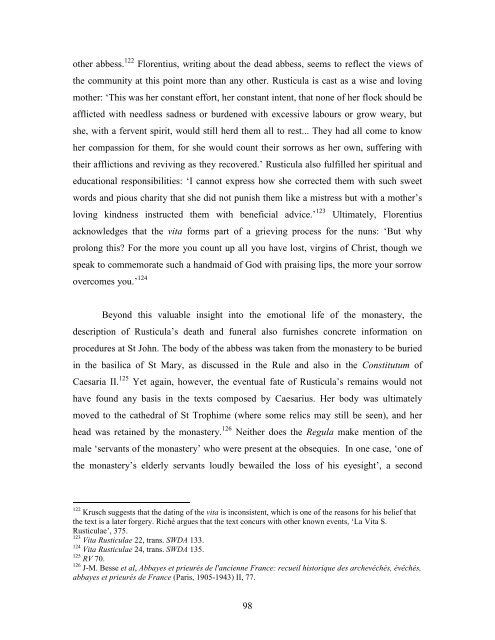Lindsay Rudge PhD Thesis - University of St Andrews
Lindsay Rudge PhD Thesis - University of St Andrews
Lindsay Rudge PhD Thesis - University of St Andrews
Create successful ePaper yourself
Turn your PDF publications into a flip-book with our unique Google optimized e-Paper software.
other abbess. 122 Florentius, writing about the dead abbess, seems to reflect the views <strong>of</strong><br />
the community at this point more than any other. Rusticula is cast as a wise and loving<br />
mother: ‘This was her constant effort, her constant intent, that none <strong>of</strong> her flock should be<br />
afflicted with needless sadness or burdened with excessive labours or grow weary, but<br />
she, with a fervent spirit, would still herd them all to rest... They had all come to know<br />
her compassion for them, for she would count their sorrows as her own, suffering with<br />
their afflictions and reviving as they recovered.’ Rusticula also fulfilled her spiritual and<br />
educational responsibilities: ‘I cannot express how she corrected them with such sweet<br />
words and pious charity that she did not punish them like a mistress but with a mother’s<br />
loving kindness instructed them with beneficial advice.’ 123 Ultimately, Florentius<br />
acknowledges that the vita forms part <strong>of</strong> a grieving process for the nuns: ‘But why<br />
prolong this? For the more you count up all you have lost, virgins <strong>of</strong> Christ, though we<br />
speak to commemorate such a handmaid <strong>of</strong> God with praising lips, the more your sorrow<br />
overcomes you.’ 124<br />
Beyond this valuable insight into the emotional life <strong>of</strong> the monastery, the<br />
description <strong>of</strong> Rusticula’s death and funeral also furnishes concrete information on<br />
procedures at <strong>St</strong> John. The body <strong>of</strong> the abbess was taken from the monastery to be buried<br />
in the basilica <strong>of</strong> <strong>St</strong> Mary, as discussed in the Rule and also in the Constitutum <strong>of</strong><br />
Caesaria II. 125 Yet again, however, the eventual fate <strong>of</strong> Rusticula’s remains would not<br />
have found any basis in the texts composed by Caesarius. Her body was ultimately<br />
moved to the cathedral <strong>of</strong> <strong>St</strong> Trophime (where some relics may still be seen), and her<br />
head was retained by the monastery. 126 Neither does the Regula make mention <strong>of</strong> the<br />
male ‘servants <strong>of</strong> the monastery’ who were present at the obsequies. In one case, ‘one <strong>of</strong><br />
the monastery’s elderly servants loudly bewailed the loss <strong>of</strong> his eyesight’, a second<br />
122 Krusch suggests that the dating <strong>of</strong> the vita is inconsistent, which is one <strong>of</strong> the reasons for his belief that<br />
the text is a later forgery. Riché argues that the text concurs with other known events, ‘La Vita S.<br />
Rusticulae’, 375.<br />
123 Vita Rusticulae 22, trans. SWDA 133.<br />
124 Vita Rusticulae 24, trans. SWDA 135.<br />
125 RV 70.<br />
126 J-M. Besse et al, Abbayes et prieurés de l'ancienne France: recueil historique des archevêchés, évêchés,<br />
abbayes et prieurés de France (Paris, 1905-1943) II, 77.<br />
98

















